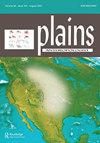Great Plains Geology
Q2 Social Sciences
引用次数: 0
Abstract
Great Plains Geology is one of two books published so far in the Discover the Great Plains Series; the other isGreat Plains Indians by David J.Wishart. Robert Diffendal’s intended audience for the book is “anyone with a broad interest in geology and some general education in science, professional geologists and geographers wanting to become more familiar with the region, and students, farmers, ranchers, and K-12 educators who want to know about the Great Plains and its geological development.” While archaeologists are not listed among those for whom the book is targeted, Diffendal does provide some geological context for a few important Paleoindian sites in the Great Plains. Diffendal has divided his book into three main sections after the Introduction. His Introduction contains a full-color geological time scale with major Earth impacts by asteroids, times of large extinctions, and glaciations noted on the scale. The time scale is his background for discussing the evolution of the Great Plains in Chapter 2 and rock formations at 57 sites across the Great Plains from Alberta, Canada to southwestern Texas in Chapter 3. His introduction also includes a discussion of more than 50 geographic definitions of the Great Plains. In Chapter 1, “What is the Great Plains” (12 pages), Diffendal argues for his own boundaries of the Great Plains while generally following Charles B. Hunt’s (1974) definition of physiographic regions. Diffendal uses “uplift, earthquake faulting, bending and folding of rock layers, volcanism, or a combination of these processes” to define his 10 sections of the Great Plains. Two of his 10 sections are subdivided. One subdivision is based on glaciated versus unglaciated, and the other on abrupt, yet small in areal extent, uplift of hills (Cypress Hills of Alberta). Chapter 2, “Geologic History of the Great Plains” (20 pages), addresses tectonics, sea-level changes, glaciation, and accompanying drainage changes in the Great Plains. Chapter 2 is a succinct introduction to the geologic development of the Great Plains. Diffendal graphically outlines, at two times during the Upper Cretaceous Period, the area of the Western Interior Seaway that stretched from the Arctic Ocean to the Gulf of Mexico. This provides a large part of his background for the sedimentary rocks found in the Great Plains. Chapter 3 ofGreat Plains Geology, “Visiting the Great Plains”, highlights 57 sites that illustrate the geology and development of the Great Plains. Some are national parks, more are national monuments, and some are state parks or recreation areas. Very few are on private land, so most are readily accessible by the public. Diffendal labels each of the 57 sites with one of more of the following features: geological, paleontological, archaeological, and ecotourism. Interestingly, the first and last sites of Diffendal’s survey of locations in the Great Plains are archaeological sites. He begins his discussion with the Head Smashed-In Buffalo Jump site in Alberta, Canada, his most western site. He ends the chapter with a discussion of the Middle Archaic Fate Bell Shelter in Seminole Canyon State Park, southern Texas, along a tributary to the Rio Grande. Between these two sites you will enjoy reading about the geology of fourteen other archaeological and historical sites. While sixteen of the 57 sites listed by Diffendal in his book are classified as archaeological sites, four would be more accurately labeled as historical sites (Pompeii’s Pillar National plains anthropologist, Vol. 65 No. 255, August 2020, 274–279大平原地质学
《大平原地质学》是迄今为止出版的《发现大平原》系列的两本书之一;另一本是大卫·j·维沙尔的《大平原印第安人》。罗伯特·迪芬达尔(Robert Diffendal)这本书的目标读者是“任何对地质学有广泛兴趣并接受过一些普通科学教育的人,想要更熟悉该地区的专业地质学家和地理学家,以及想要了解大平原及其地质发展的学生、农民、牧场主和K-12教育工作者。”虽然考古学家没有被列入本书的目标人群,但迪芬达尔确实为大平原上一些重要的古印第安遗址提供了一些地质背景。在引言之后,迪芬达尔将他的书分为三个主要部分。他的介绍包含了一个全彩色的地质时间尺度,其中包括小行星对地球的主要影响,大灭绝的时间,以及尺度上的冰川作用。时间尺度是他在第二章中讨论大平原演变的背景,在第三章中讨论从加拿大阿尔伯塔到德克萨斯州西南部的大平原上的57个地点的岩层。他的介绍还包括对大平原50多个地理定义的讨论。在第1章“什么是大平原”(12页)中,迪芬达尔在遵循查尔斯·b·亨特(Charles B. Hunt, 1974)对地理区域的定义的同时,提出了自己对大平原的界定。迪芬迪用“隆起、地震断层、岩层的弯曲和折叠、火山作用或这些过程的组合”来定义大平原的10个部分。他的10个章节中有两个被细分了。一个细分是基于冰川和未冰川,另一个是基于突然的,但面积很小的隆起(阿尔伯塔的柏树山)。第二章,“大平原的地质历史”(20页),讨论了大平原的构造、海平面变化、冰川作用和伴随的排水变化。第二章是对大平原地质发展的简要介绍。在上白垩纪的两个时期,Diffendal图解地勾勒出了从北冰洋延伸到墨西哥湾的西部内陆海道区域。这为他在大平原上发现的沉积岩提供了很大一部分背景资料。《大平原地质学》的第三章“游览大平原”,重点介绍了57个展示大平原地质和发展的景点。有些是国家公园,更多的是国家纪念碑,还有一些是州立公园或休闲区。很少有在私人土地上,所以大多数都很容易被公众进入。迪弗尔将这57个景点分别标记为以下特征之一:地质、古生物、考古和生态旅游。有趣的是,迪芬达尔在大平原地区调查的第一个和最后一个地点都是考古遗址。他从加拿大阿尔伯塔省的Head smashing - in Buffalo Jump网站开始讨论,这是他最西部的网站。他在这一章的最后讨论了位于德克萨斯州南部塞米诺尔峡谷州立公园的中世纪命运贝尔避难所,沿着里约热内卢格兰德的一条支流。在这两个地点之间,你会喜欢阅读其他14个考古和历史遗址的地质学知识。迪芬达尔在他的书中列出的57个遗址中,有16个被归类为考古遗址,有4个被更准确地标记为历史遗址(庞贝的柱子国家平原人类学家,Vol. 65 No. 255, August 2020, 274-279)
本文章由计算机程序翻译,如有差异,请以英文原文为准。
求助全文
约1分钟内获得全文
求助全文

 求助内容:
求助内容: 应助结果提醒方式:
应助结果提醒方式:


